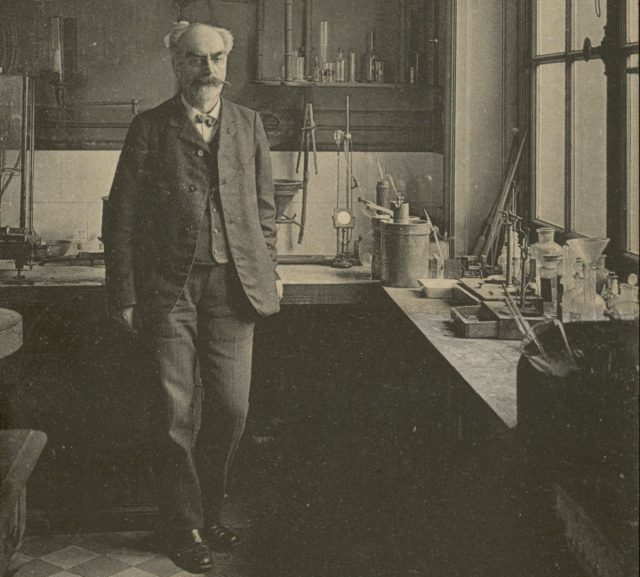The bright iridescent colors in butterfly wings or beetle shells don't come from any pigment molecules but from how the wings are structured—a naturally occurring example of what physicists call photonic crystals. Scientists can make their own structural colored materials in the lab, but it can be challenging to scale up the process for commercial applications without sacrificing optical precision.
Now MIT scientists have adapted a 19th-century holographic photography technique to develop chameleon-like films that change color when stretched. The method can be easily scaled while preserving nanoscale optical precision. They described their work in a new paper published in the journal Nature Materials.
In nature, scales of chitin (a polysaccharide common to insects) are arranged like roof tiles. Essentially, they form a diffraction grating, except photonic crystals only produce specific colors, or wavelengths, of light, while a diffraction grating will produce the entire spectrum, much like a prism. Also known as photonic band gap materials, photonic crystals are "tunable," which means they are precisely ordered to block certain wavelengths of light while letting others through. Alter the structure by changing the size of the tiles, and the crystals become sensitive to a different wavelength.
Creating structural colors like those found in nature is an active area of materials research. Optical sensing and visual communication applications, for instance, would benefit from structurally colored materials that change hue in response to mechanical stimuli. There are several techniques for making such materials, but none of those methods can both control the structure at the small scales required and scale up beyond laboratory settings.

Then co-author Benjamin Miller, a graduate student at MIT, discovered an exhibit on holography at the MIT Museum and realized that creating a hologram was similar in some respects to how nature produces structural color. He delved into the history of holography and learned about a late 19th-century color photography technique invented by physicist Gabriel Lippmann.
As we've reported previously, Lippmann became interested in developing a means of fixing the colors of the solar spectrum onto a photographic plate in 1886, "whereby the image remains fixed and can remain in daylight without deterioration." He achieved that goal in 1891, producing color images of a stained-glass window, a bowl of oranges, and a colorful parrot, as well as landscapes and portraits—including a self-portrait.
Lippmann's color photography process involved projecting the optical image as usual onto a photographic plate. The projection was done through a glass plate coated with a transparent emulsion of very fine silver halide grains on the other side. There was also a liquid mercury mirror in contact with the emulsion, so the projected light traveled through the emulsion, hit the mirror, and was reflected back into the emulsion.
The resulting light interference pattern exposed the emulsion at different depths, essentially encoding the emulsion in that interference pattern. After several minutes of exposure, the plate was removed from the liquid mercury and processed.
For viewing purposes, the finished plate would be turned upside down, and a prism was attached to the surface, typically with a Canada-balsam adhesive. Then the plate would be lit from the front at a perpendicular angle with white light. At any point on the plate where the wavelength of light that had generated the laminae matched the wavelength of the incoming light, it would be reflected toward the viewer; other wavelengths would be absorbed or scattered by the silver grains or just pass through the emulsion to be absorbed by a black anti-reflective coating on the plate's back.
Lippmann's process never caught on commercially, mainly because it required long exposure times, and there was no way to make color prints. Fortunately, holographic materials—made of light-sensitive molecules that cross-link to form colored mirrors when exposed to light—have come a long way since Lippmann's era. "The chemistries of these modern holographic materials are now so responsive that it's possible to do this technique on a short timescale simply with a projector," said co-author Mathias Kolle.
The team placed a commercial elastomeric photopolymer against an aluminum sheet and projected various images onto the sample using a standard off-the-shelf projector. It took minutes to produce large, detailed vividly colored images. Then they peeled off the holographic film and stuck it onto a black elastic silicone substrate.
When they stretched the film, the colors changed since the stretching and thinning of the film caused the nanoscale structure to reconfigure, reflecting slightly different wavelengths. The film remained red where the backing was thinnest, shifting to blue in thicker sections. Furthermore, pressing things into the red film—like strawberry seeds, coins, or fingers—left detailed green imprints.
"Now that we've cleared this scaling hurdle, we can explore questions like: Can we use this material to make robotic skin that has a human-like sense of touch? And can we create touch-sensing devices for things like virtual augmented reality or medical training?" said Miller. "It's a big space we're looking at now."
These color-changing films would be ideal for making bandages that change color in response to pressure, letting medical professionals know if they are wrapping a wound too tightly—an important factor when treating conditions like venous ulcers, pressure ulcers, lymphoedema, and scarring. Children would love wearing bandages that change color, providing a boon for pediatricians. And being able to make large sheets of the material opens up applications in apparel and sportswear. "Lippmann's materials wouldn't have allowed him to even produce a Speedo," said Kolle. "Now we could make a full leotard."
The MIT team also discovered it could project hidden images by tilting the film at an angle during the photographic process, offering a means of encoding secret messages. Using red light during exposure would create a film that reflects in the infrared, which is invisible to humans. Stretching the resulting film would shift the image into the red, revealing the hidden image.
DOI: Nature Materials, 2022. 10.1038/s41563-022-01318-x (About DOIs).
https://ift.tt/D7PZnkj
Science
No comments:
Post a Comment